NUR 735: Epidemiology Assignment - Foodborne Outbreak
VerifiedAdded on 2022/08/29
|7
|1486
|25
Homework Assignment
AI Summary
This assignment explores the core concepts of epidemiology, focusing on disease prevalence, transmission, and population health. It delves into the role of biostatistics in analyzing disease rates and developing health services, emphasizing both qualitative and quantitative data analysis. The assignment examines emerging infectious and chronic diseases, highlighting the influence of genetic and environmental factors, and the impact of epidemiology on public health policies. It also addresses the design of healthcare delivery services, incorporating evidence-based approaches to promote health, and the integration of statistical and epidemiological methods. The assignment includes a detailed analysis of a foodborne outbreak scenario, outlining investigation methods, data collection, and strategies to contain and solve the outbreak, along with media communication strategies. The solution references key literature to support the analysis.

Running Head: EPIDEMIOLOGY
EPIDEMIOLOGY
Name of the Student
Name of the University
Author’s Note
EPIDEMIOLOGY
Name of the Student
Name of the University
Author’s Note
Paraphrase This Document
Need a fresh take? Get an instant paraphrase of this document with our AI Paraphraser
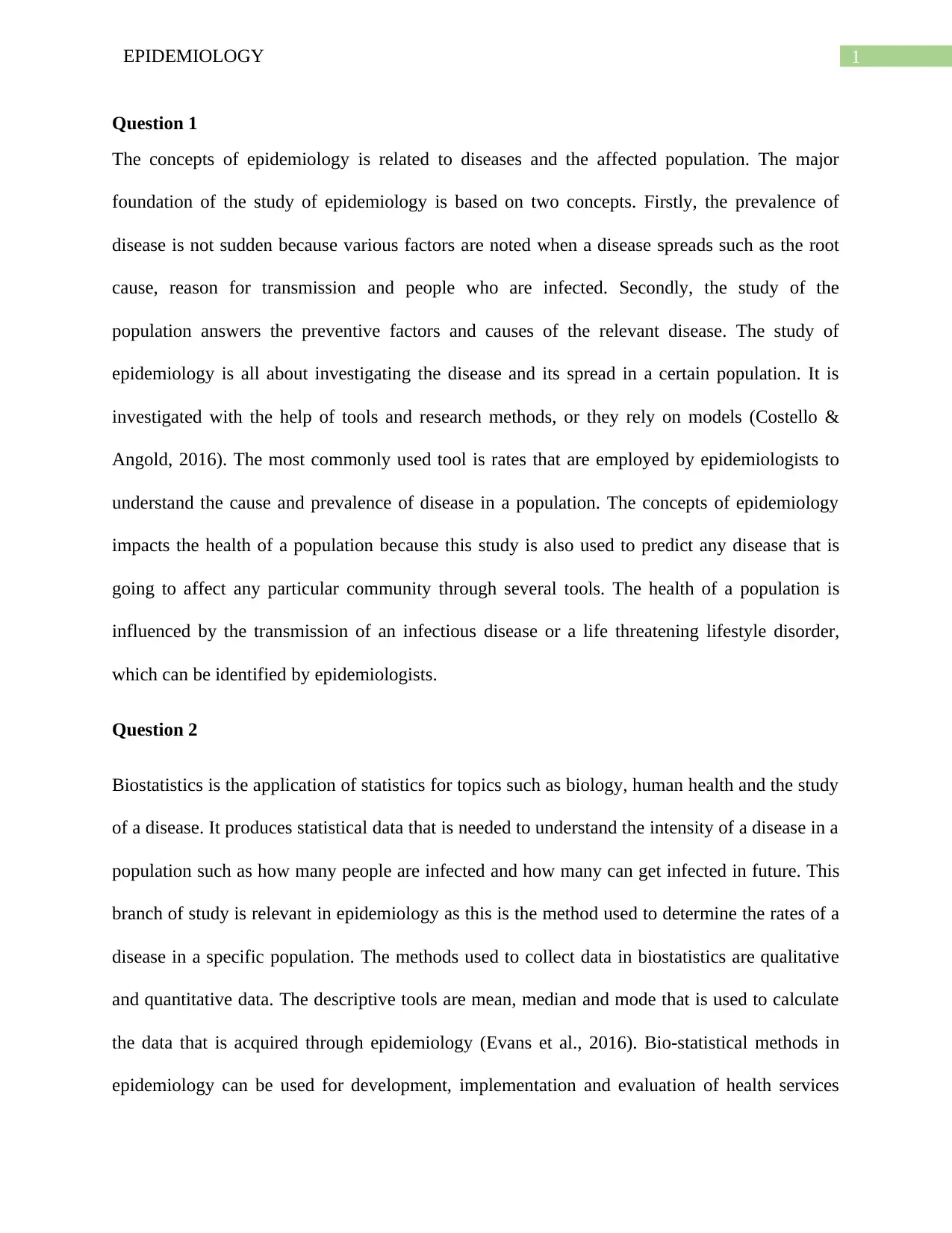
1EPIDEMIOLOGY
Question 1
The concepts of epidemiology is related to diseases and the affected population. The major
foundation of the study of epidemiology is based on two concepts. Firstly, the prevalence of
disease is not sudden because various factors are noted when a disease spreads such as the root
cause, reason for transmission and people who are infected. Secondly, the study of the
population answers the preventive factors and causes of the relevant disease. The study of
epidemiology is all about investigating the disease and its spread in a certain population. It is
investigated with the help of tools and research methods, or they rely on models (Costello &
Angold, 2016). The most commonly used tool is rates that are employed by epidemiologists to
understand the cause and prevalence of disease in a population. The concepts of epidemiology
impacts the health of a population because this study is also used to predict any disease that is
going to affect any particular community through several tools. The health of a population is
influenced by the transmission of an infectious disease or a life threatening lifestyle disorder,
which can be identified by epidemiologists.
Question 2
Biostatistics is the application of statistics for topics such as biology, human health and the study
of a disease. It produces statistical data that is needed to understand the intensity of a disease in a
population such as how many people are infected and how many can get infected in future. This
branch of study is relevant in epidemiology as this is the method used to determine the rates of a
disease in a specific population. The methods used to collect data in biostatistics are qualitative
and quantitative data. The descriptive tools are mean, median and mode that is used to calculate
the data that is acquired through epidemiology (Evans et al., 2016). Bio-statistical methods in
epidemiology can be used for development, implementation and evaluation of health services
Question 1
The concepts of epidemiology is related to diseases and the affected population. The major
foundation of the study of epidemiology is based on two concepts. Firstly, the prevalence of
disease is not sudden because various factors are noted when a disease spreads such as the root
cause, reason for transmission and people who are infected. Secondly, the study of the
population answers the preventive factors and causes of the relevant disease. The study of
epidemiology is all about investigating the disease and its spread in a certain population. It is
investigated with the help of tools and research methods, or they rely on models (Costello &
Angold, 2016). The most commonly used tool is rates that are employed by epidemiologists to
understand the cause and prevalence of disease in a population. The concepts of epidemiology
impacts the health of a population because this study is also used to predict any disease that is
going to affect any particular community through several tools. The health of a population is
influenced by the transmission of an infectious disease or a life threatening lifestyle disorder,
which can be identified by epidemiologists.
Question 2
Biostatistics is the application of statistics for topics such as biology, human health and the study
of a disease. It produces statistical data that is needed to understand the intensity of a disease in a
population such as how many people are infected and how many can get infected in future. This
branch of study is relevant in epidemiology as this is the method used to determine the rates of a
disease in a specific population. The methods used to collect data in biostatistics are qualitative
and quantitative data. The descriptive tools are mean, median and mode that is used to calculate
the data that is acquired through epidemiology (Evans et al., 2016). Bio-statistical methods in
epidemiology can be used for development, implementation and evaluation of health services
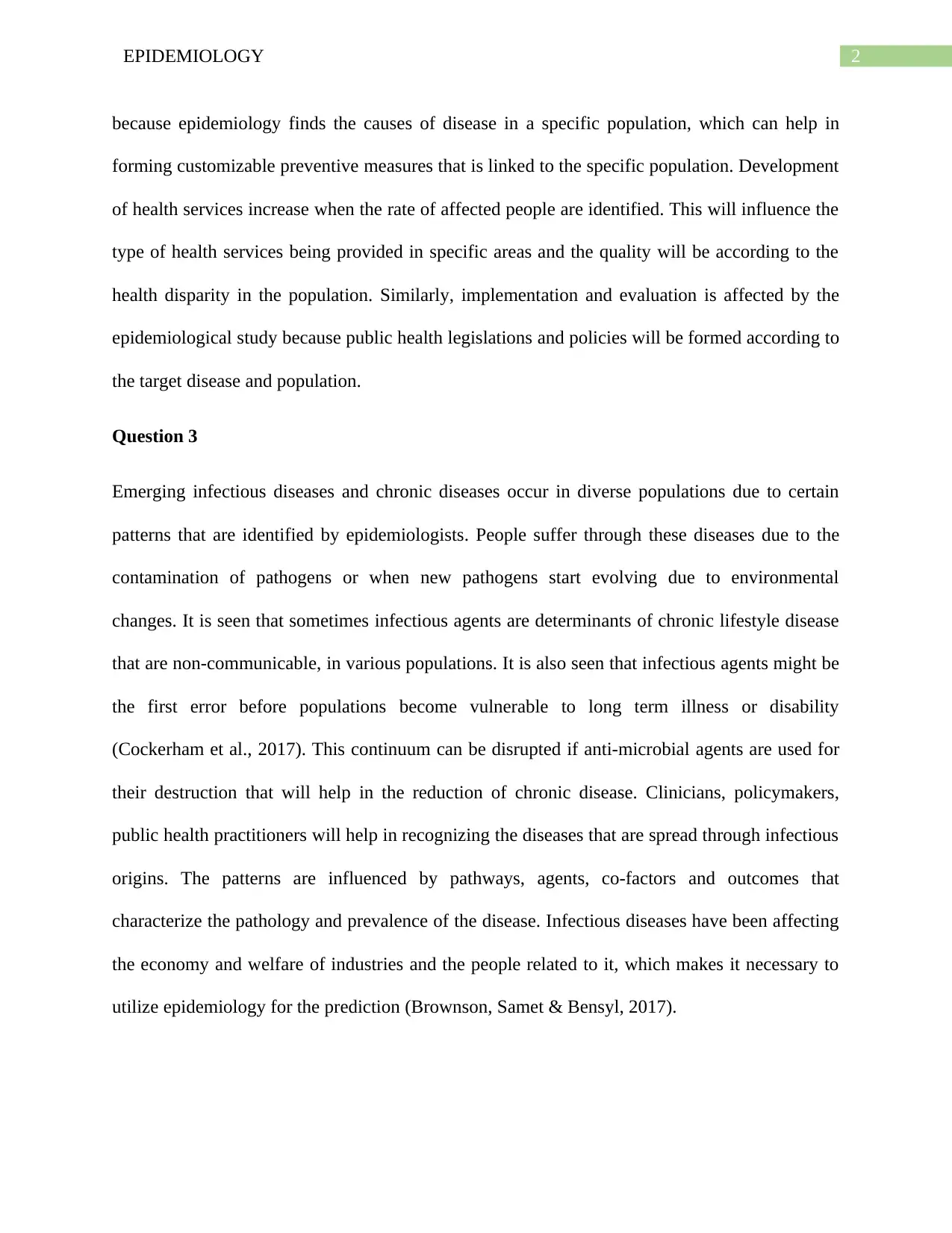
2EPIDEMIOLOGY
because epidemiology finds the causes of disease in a specific population, which can help in
forming customizable preventive measures that is linked to the specific population. Development
of health services increase when the rate of affected people are identified. This will influence the
type of health services being provided in specific areas and the quality will be according to the
health disparity in the population. Similarly, implementation and evaluation is affected by the
epidemiological study because public health legislations and policies will be formed according to
the target disease and population.
Question 3
Emerging infectious diseases and chronic diseases occur in diverse populations due to certain
patterns that are identified by epidemiologists. People suffer through these diseases due to the
contamination of pathogens or when new pathogens start evolving due to environmental
changes. It is seen that sometimes infectious agents are determinants of chronic lifestyle disease
that are non-communicable, in various populations. It is also seen that infectious agents might be
the first error before populations become vulnerable to long term illness or disability
(Cockerham et al., 2017). This continuum can be disrupted if anti-microbial agents are used for
their destruction that will help in the reduction of chronic disease. Clinicians, policymakers,
public health practitioners will help in recognizing the diseases that are spread through infectious
origins. The patterns are influenced by pathways, agents, co-factors and outcomes that
characterize the pathology and prevalence of the disease. Infectious diseases have been affecting
the economy and welfare of industries and the people related to it, which makes it necessary to
utilize epidemiology for the prediction (Brownson, Samet & Bensyl, 2017).
because epidemiology finds the causes of disease in a specific population, which can help in
forming customizable preventive measures that is linked to the specific population. Development
of health services increase when the rate of affected people are identified. This will influence the
type of health services being provided in specific areas and the quality will be according to the
health disparity in the population. Similarly, implementation and evaluation is affected by the
epidemiological study because public health legislations and policies will be formed according to
the target disease and population.
Question 3
Emerging infectious diseases and chronic diseases occur in diverse populations due to certain
patterns that are identified by epidemiologists. People suffer through these diseases due to the
contamination of pathogens or when new pathogens start evolving due to environmental
changes. It is seen that sometimes infectious agents are determinants of chronic lifestyle disease
that are non-communicable, in various populations. It is also seen that infectious agents might be
the first error before populations become vulnerable to long term illness or disability
(Cockerham et al., 2017). This continuum can be disrupted if anti-microbial agents are used for
their destruction that will help in the reduction of chronic disease. Clinicians, policymakers,
public health practitioners will help in recognizing the diseases that are spread through infectious
origins. The patterns are influenced by pathways, agents, co-factors and outcomes that
characterize the pathology and prevalence of the disease. Infectious diseases have been affecting
the economy and welfare of industries and the people related to it, which makes it necessary to
utilize epidemiology for the prediction (Brownson, Samet & Bensyl, 2017).
⊘ This is a preview!⊘
Do you want full access?
Subscribe today to unlock all pages.

Trusted by 1+ million students worldwide
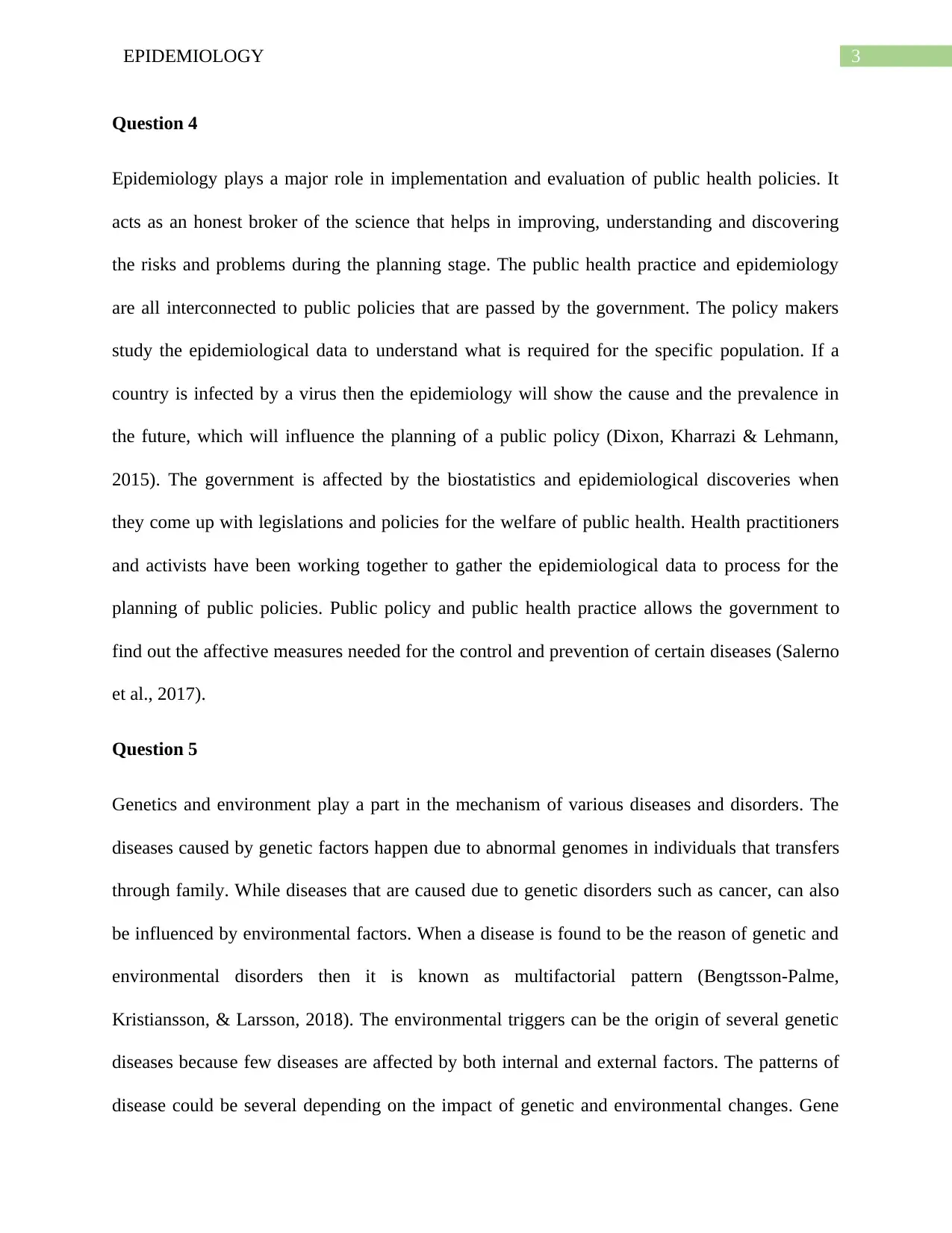
3EPIDEMIOLOGY
Question 4
Epidemiology plays a major role in implementation and evaluation of public health policies. It
acts as an honest broker of the science that helps in improving, understanding and discovering
the risks and problems during the planning stage. The public health practice and epidemiology
are all interconnected to public policies that are passed by the government. The policy makers
study the epidemiological data to understand what is required for the specific population. If a
country is infected by a virus then the epidemiology will show the cause and the prevalence in
the future, which will influence the planning of a public policy (Dixon, Kharrazi & Lehmann,
2015). The government is affected by the biostatistics and epidemiological discoveries when
they come up with legislations and policies for the welfare of public health. Health practitioners
and activists have been working together to gather the epidemiological data to process for the
planning of public policies. Public policy and public health practice allows the government to
find out the affective measures needed for the control and prevention of certain diseases (Salerno
et al., 2017).
Question 5
Genetics and environment play a part in the mechanism of various diseases and disorders. The
diseases caused by genetic factors happen due to abnormal genomes in individuals that transfers
through family. While diseases that are caused due to genetic disorders such as cancer, can also
be influenced by environmental factors. When a disease is found to be the reason of genetic and
environmental disorders then it is known as multifactorial pattern (Bengtsson-Palme,
Kristiansson, & Larsson, 2018). The environmental triggers can be the origin of several genetic
diseases because few diseases are affected by both internal and external factors. The patterns of
disease could be several depending on the impact of genetic and environmental changes. Gene
Question 4
Epidemiology plays a major role in implementation and evaluation of public health policies. It
acts as an honest broker of the science that helps in improving, understanding and discovering
the risks and problems during the planning stage. The public health practice and epidemiology
are all interconnected to public policies that are passed by the government. The policy makers
study the epidemiological data to understand what is required for the specific population. If a
country is infected by a virus then the epidemiology will show the cause and the prevalence in
the future, which will influence the planning of a public policy (Dixon, Kharrazi & Lehmann,
2015). The government is affected by the biostatistics and epidemiological discoveries when
they come up with legislations and policies for the welfare of public health. Health practitioners
and activists have been working together to gather the epidemiological data to process for the
planning of public policies. Public policy and public health practice allows the government to
find out the affective measures needed for the control and prevention of certain diseases (Salerno
et al., 2017).
Question 5
Genetics and environment play a part in the mechanism of various diseases and disorders. The
diseases caused by genetic factors happen due to abnormal genomes in individuals that transfers
through family. While diseases that are caused due to genetic disorders such as cancer, can also
be influenced by environmental factors. When a disease is found to be the reason of genetic and
environmental disorders then it is known as multifactorial pattern (Bengtsson-Palme,
Kristiansson, & Larsson, 2018). The environmental triggers can be the origin of several genetic
diseases because few diseases are affected by both internal and external factors. The patterns of
disease could be several depending on the impact of genetic and environmental changes. Gene
Paraphrase This Document
Need a fresh take? Get an instant paraphrase of this document with our AI Paraphraser
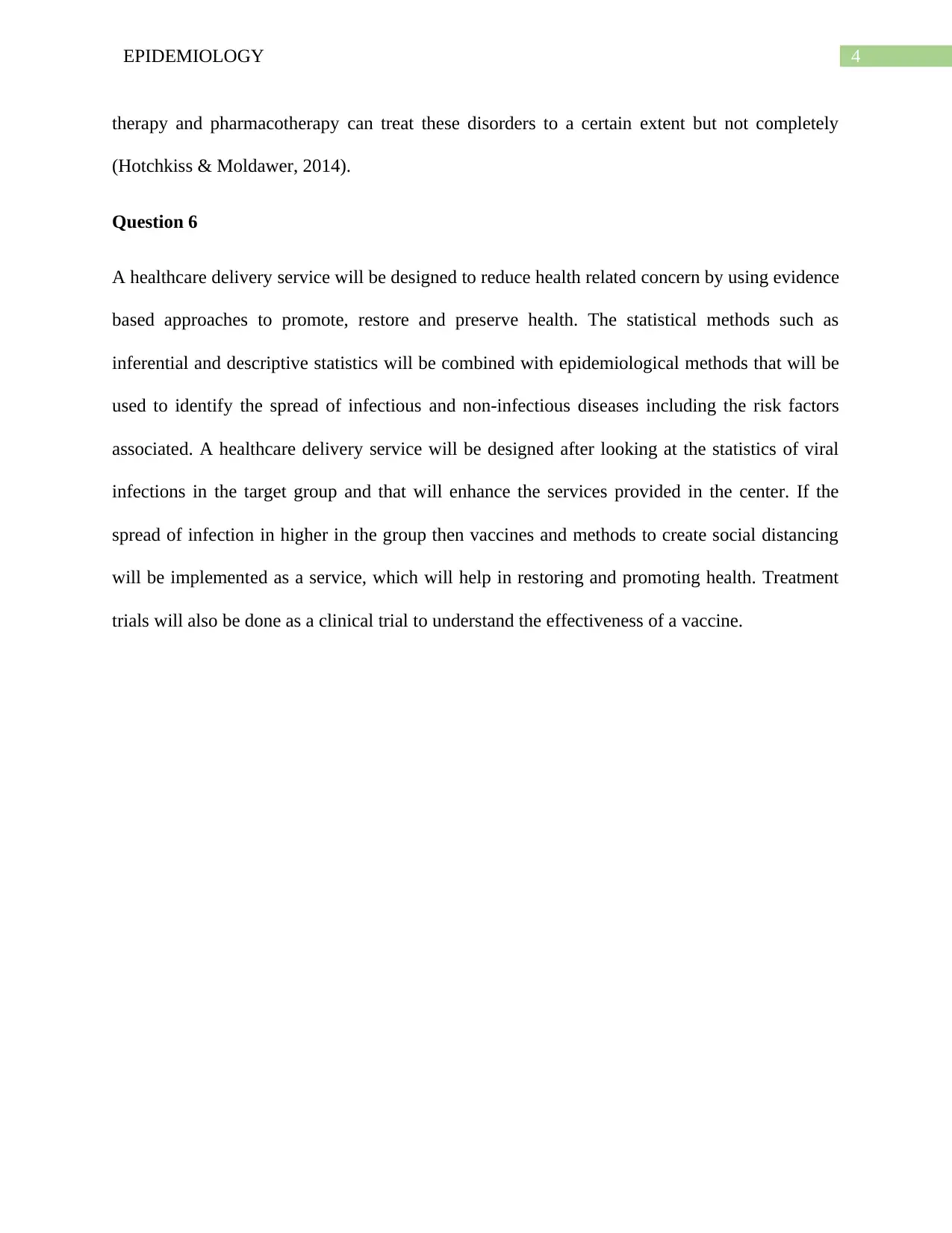
4EPIDEMIOLOGY
therapy and pharmacotherapy can treat these disorders to a certain extent but not completely
(Hotchkiss & Moldawer, 2014).
Question 6
A healthcare delivery service will be designed to reduce health related concern by using evidence
based approaches to promote, restore and preserve health. The statistical methods such as
inferential and descriptive statistics will be combined with epidemiological methods that will be
used to identify the spread of infectious and non-infectious diseases including the risk factors
associated. A healthcare delivery service will be designed after looking at the statistics of viral
infections in the target group and that will enhance the services provided in the center. If the
spread of infection in higher in the group then vaccines and methods to create social distancing
will be implemented as a service, which will help in restoring and promoting health. Treatment
trials will also be done as a clinical trial to understand the effectiveness of a vaccine.
therapy and pharmacotherapy can treat these disorders to a certain extent but not completely
(Hotchkiss & Moldawer, 2014).
Question 6
A healthcare delivery service will be designed to reduce health related concern by using evidence
based approaches to promote, restore and preserve health. The statistical methods such as
inferential and descriptive statistics will be combined with epidemiological methods that will be
used to identify the spread of infectious and non-infectious diseases including the risk factors
associated. A healthcare delivery service will be designed after looking at the statistics of viral
infections in the target group and that will enhance the services provided in the center. If the
spread of infection in higher in the group then vaccines and methods to create social distancing
will be implemented as a service, which will help in restoring and promoting health. Treatment
trials will also be done as a clinical trial to understand the effectiveness of a vaccine.
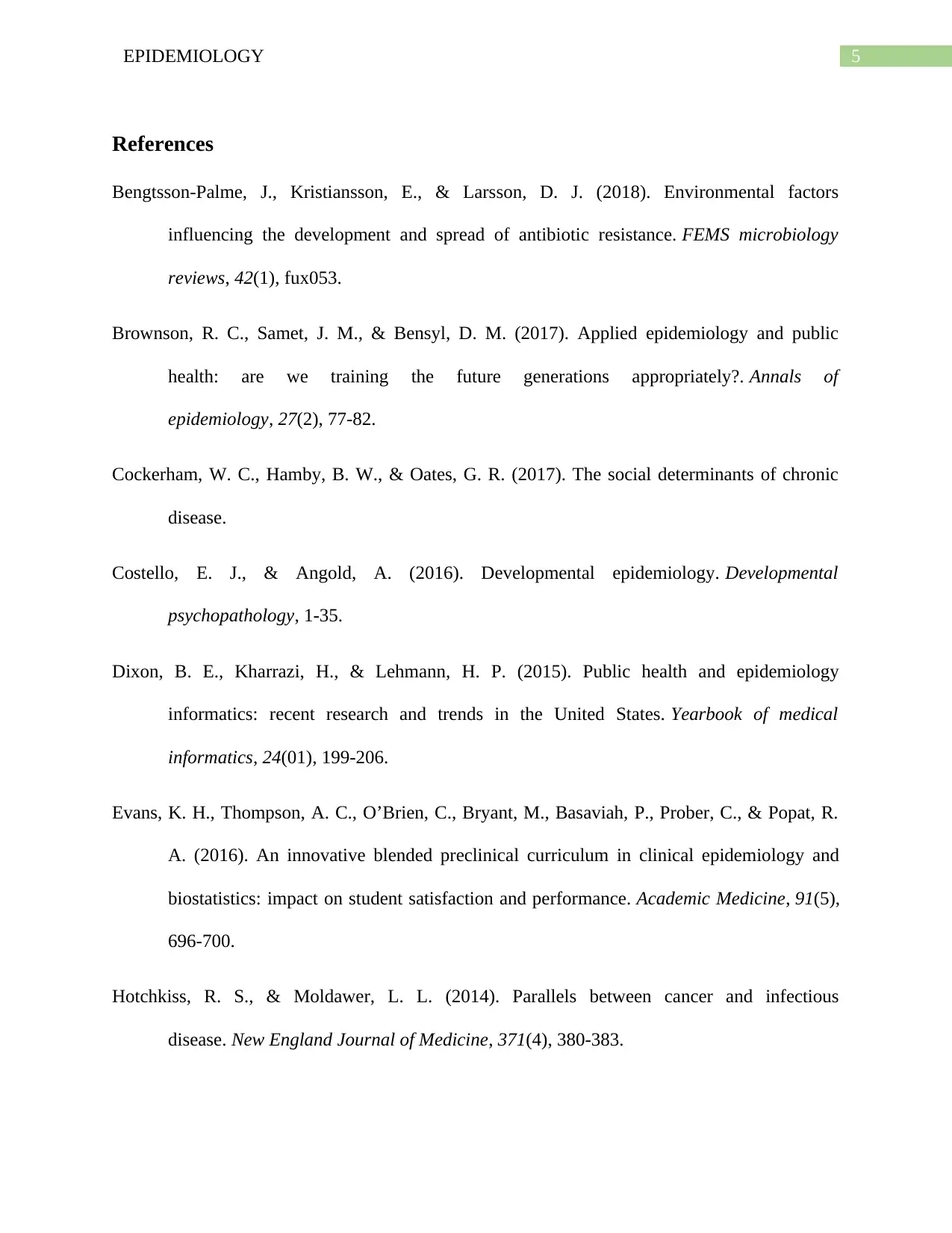
5EPIDEMIOLOGY
References
Bengtsson-Palme, J., Kristiansson, E., & Larsson, D. J. (2018). Environmental factors
influencing the development and spread of antibiotic resistance. FEMS microbiology
reviews, 42(1), fux053.
Brownson, R. C., Samet, J. M., & Bensyl, D. M. (2017). Applied epidemiology and public
health: are we training the future generations appropriately?. Annals of
epidemiology, 27(2), 77-82.
Cockerham, W. C., Hamby, B. W., & Oates, G. R. (2017). The social determinants of chronic
disease.
Costello, E. J., & Angold, A. (2016). Developmental epidemiology. Developmental
psychopathology, 1-35.
Dixon, B. E., Kharrazi, H., & Lehmann, H. P. (2015). Public health and epidemiology
informatics: recent research and trends in the United States. Yearbook of medical
informatics, 24(01), 199-206.
Evans, K. H., Thompson, A. C., O’Brien, C., Bryant, M., Basaviah, P., Prober, C., & Popat, R.
A. (2016). An innovative blended preclinical curriculum in clinical epidemiology and
biostatistics: impact on student satisfaction and performance. Academic Medicine, 91(5),
696-700.
Hotchkiss, R. S., & Moldawer, L. L. (2014). Parallels between cancer and infectious
disease. New England Journal of Medicine, 371(4), 380-383.
References
Bengtsson-Palme, J., Kristiansson, E., & Larsson, D. J. (2018). Environmental factors
influencing the development and spread of antibiotic resistance. FEMS microbiology
reviews, 42(1), fux053.
Brownson, R. C., Samet, J. M., & Bensyl, D. M. (2017). Applied epidemiology and public
health: are we training the future generations appropriately?. Annals of
epidemiology, 27(2), 77-82.
Cockerham, W. C., Hamby, B. W., & Oates, G. R. (2017). The social determinants of chronic
disease.
Costello, E. J., & Angold, A. (2016). Developmental epidemiology. Developmental
psychopathology, 1-35.
Dixon, B. E., Kharrazi, H., & Lehmann, H. P. (2015). Public health and epidemiology
informatics: recent research and trends in the United States. Yearbook of medical
informatics, 24(01), 199-206.
Evans, K. H., Thompson, A. C., O’Brien, C., Bryant, M., Basaviah, P., Prober, C., & Popat, R.
A. (2016). An innovative blended preclinical curriculum in clinical epidemiology and
biostatistics: impact on student satisfaction and performance. Academic Medicine, 91(5),
696-700.
Hotchkiss, R. S., & Moldawer, L. L. (2014). Parallels between cancer and infectious
disease. New England Journal of Medicine, 371(4), 380-383.
⊘ This is a preview!⊘
Do you want full access?
Subscribe today to unlock all pages.

Trusted by 1+ million students worldwide

6EPIDEMIOLOGY
Salerno, J., Knoppers, B. M., Lee, L. M., Hlaing, W. M., & Goodman, K. W. (2017). Ethics, big
data and computing in epidemiology and public health. Annals of epidemiology, 27(5),
297-301.
Salerno, J., Knoppers, B. M., Lee, L. M., Hlaing, W. M., & Goodman, K. W. (2017). Ethics, big
data and computing in epidemiology and public health. Annals of epidemiology, 27(5),
297-301.
1 out of 7
Related Documents
Your All-in-One AI-Powered Toolkit for Academic Success.
+13062052269
info@desklib.com
Available 24*7 on WhatsApp / Email
![[object Object]](/_next/static/media/star-bottom.7253800d.svg)
Unlock your academic potential
Copyright © 2020–2025 A2Z Services. All Rights Reserved. Developed and managed by ZUCOL.





